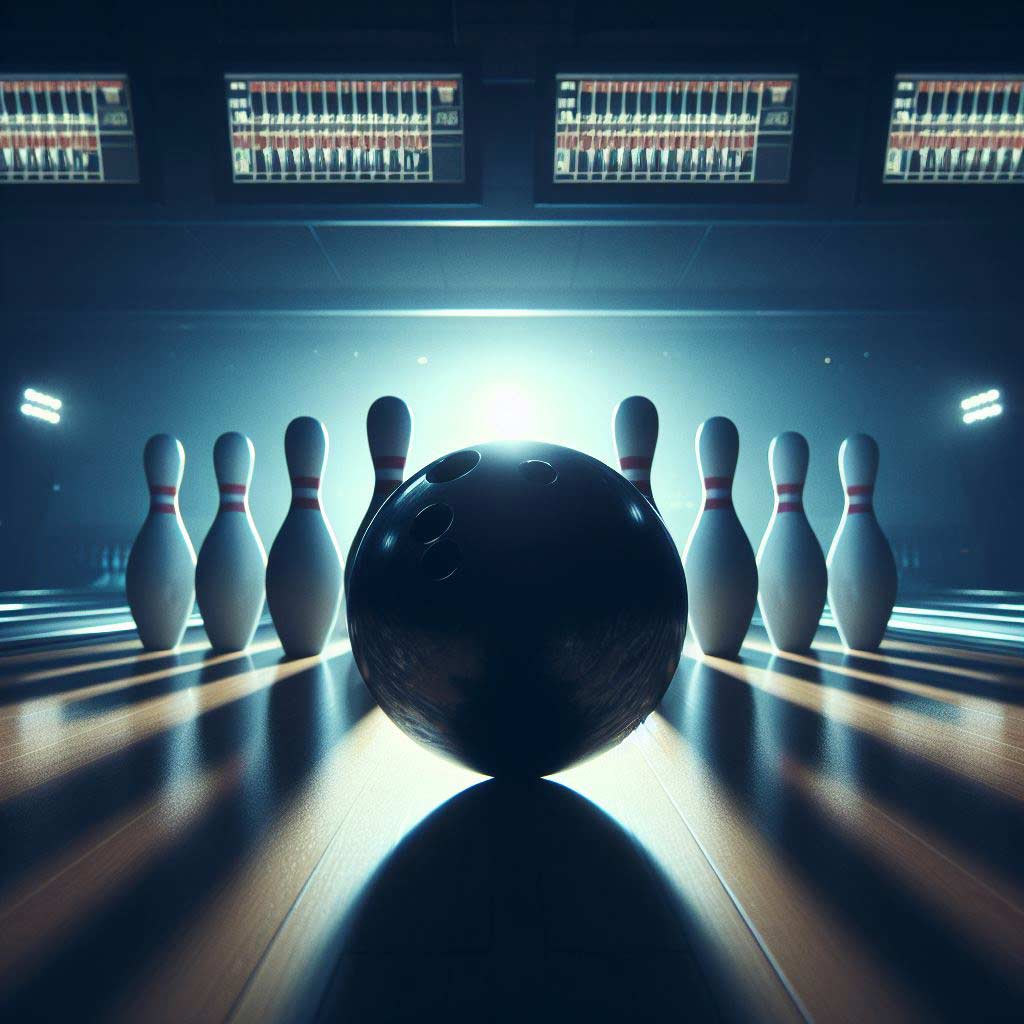Getting a strike is the peak accomplishment in bowling. Nothing beats seeing all 10 pins topple over with one perfect roll. While it takes skill, the right aim and approach are key to making consistent strikes.
So where exactly should bowlers aim to knock down every pin? What targeting and adjustments help to best set up throwing a strike? This article explains it all. Follow these aiming pointers for bowling excellence.
Stand in the Right Starting Position
Proper starting positioning sets the stage for bowling success. Stand centered – look for the dots placed on most lane surfaces marking the halfway point from gutter to gutter. Standing focused here initially allows room for the ball to curve properly after release.
Stance is also directional based on handedness:
- Left-handed bowlers should align their feet slightly right of center.
- Right-handed bowlers should stand left of the middle dots by a comparable margin.
This lined-up direction accounts for the ball curving back the other way after being thrown. Lefties curve from right to left, so standing right prevents gutter balls. Righties see a left-to-right curve, so left footing prevents the same fate.
Feet placements impact aim. But also pay attention to shoulder alignment when getting set pre-approach. They should mirror the feet, opened slightly toward the non-dominant hand side.
With centered footing and angled shoulders, let’s examine exact board targets for strikes.
Specific Board Targets Based on Release Hand
Bowlers should zero focus on the front triangle pins specifically surrounding the “pocket” area. This refers to the gap separating the front head pin (1 pin) and the corner pin beside it (3 pin). Filling this pocket consistently gives the best statistical chance to garner a strike.
But what specific boards to target on the lane itself? It again depends on release hand dominance.
Right-Handed Bowlers
For right-handed throwers, the best board range spans from around 17 to 8. That equates to feet aligned slightly left of center using the dots.
During the approach, envision releasing the ball to initially track over the center arrow target down the lane. For house shot lane conditions in particular, visualizing roll from board 17 through 8 creates an ideal entry angle into the pocket to flush all 10 pins.
Specific targets rotating the shoulder and arm back include:
- 1st arrow: Roll overboard 15 toward the pocket
- 2nd arrow: Track over boards 12-13
- 3rd arrow: Release crosses board 9
Adjust the roll angle based on whether the ball angle seems too sharp or wide of the pocket from prior efforts. But using the 2nd arrow as the prime target gives a reliable benchmark for righties.
Left-Handed Bowlers
Do southpaws need to mirror an exact opposite line? Not necessarily – the key again lies in envisioning the lane direction the ball rolls after release.
Lefties need their arc sending the ball right to left towards the 1-3 pocket. So initial positioning and swing shoulder should open slightly right of center.
Strike targeting for left-handed throwers falls around boards 13 down to 5. Essentially the opposite board flips from conventional righty territory.
Tracking over the 2nd arrow is again smart, using board counts including:
- 1st arrow: Initial track overboard 11
- 2nd arrow: Ideal roll crosses board 8
- 3rd arrow: Ball passes overboard 5 area
Adapt aiming for comfort and keeping the arc shape consistently into the pins. But consensus suggests lefties find the most success using the 2nd arrow breakpoint to steer into the pocket.
Practice Adjustments Based on Pin Layout
Now on to addressing varied pin setups. The principles stay the same whether rolling during open bowling play or organized league. Only shift initial aiming if the pins shift before throwing.
The standard triangular rack seen before every frame features the 1-pin out front and center. The other pins fan out slightly behind in uniform alignment.
If the lane operator leaves everything in the classic formation, simply stick to the aiming advice covered already. No need to reinvent the technique each time when the pins reset spot-on pre-roll.
But not all pin configurations look the same. What about adjustments when seeing “off” layouts?
Split Pins
The first case is when the headpin slides left or splits away from the adjacent 3-pin. If they no longer abut one another, the pocket vanishes completely!
Luckily sparing tweaks realign things:
- For wider 1-pin shifts left, move feet and target right
- If the 1-pin slides deeper right, lefties go more left
- Minimize throw hook on straighter angles
The gutter line helps gauge foot changes. Slide either way the same boards the front pin moved to re-center aim. Reduce the hook in the ball track to cut through the widened gap now separating the pins.
Reconfiguring body alignment combined with a lessening curve better shoots through the abandoned pocket crevice.
Pins Out of Position
Additionally, back rows sometimes scatter erratically before stepping up to bowl. Status quo targeting will come up short if the setup gets shuffled drastically.
Again consider where the front headpin sits most importantly. Is it still centered out front with pins behind the fanning uniform? Or did backend pins shift or even get taken out completely from behind?
If so, widened gaps require straighter, more direct hits:
- Move left and throw firmer if large right-side gaps appear
- Slide right if more open spaces emerge left section
- Adjust the angle until comfortably surrounds the front pin
Holding back-end pin randomness is impossible…but bowlers can control realigning their adjusted approach!
Use Technique Tailoring Ball Roll
The last key factor that ties everything together – ball rotation! Mere arm strength cannot clock strikes minus putting rotational finesse on each delivery. Maximizing revolutions and axis tilt decides scoring, not just target accuracy.
Without the proper roll and tilt aligned to a hockey stick around the pocket, even dead-perfect shots slide by unproductively. Combat flat impacts by honing ball release for maximum pin action.
Matching Roll to Release Hand
No surprise here – ball rotation mirrors footwork direction. Righties tilt the top of the ball right upon release, so it curves left accordingly. Vice versa for lefties rotating the opposite way.
Bowing naturally creates sideways rotation from the dominant throwing hand. Leverage that pre-existing rotational direction for advantage rather than fighting against it.
The more profound the sideways rotation generated, the further the ball dramatizes arcing when encountering dry boards. For right-handers, maximum tilt and lift make the ball drive furthest left towards the pins. Lefties accomplish equally exaggerated moves in the opposite direction.
Practice manipulating axis tilt and lift to harness the ball’s built-in hook potential. Combining optimized rotation and smart board targeting drops pins with authority.
Training Drills to Refine Technique
Bowlers shouldn’t expect split-second mastery gaining powerful spin and accuracy. Consistency arrives only through focused drilling. What training tips expedite raising bowling games to the next level?
Install Physical Targeting Lanes
Firstly, facilities can embed visual ball tracks within the lane wood itself. Colored arrows painted ascending to the foul line assist in lining up accurate foot placement.
Some centers take things a step further installing lights shining paths towards ideal pocket entry angles. Illuminated ball tracks act like tunnel vision for improving strike percentage.
Analyze and Tweak Based On Video
Nothing teaches quicker than watching the playback of one’s form. Have coaches or friends record throwing motions from multiple angles. Does each step sync in tempo leading into the slide?
Observe hip motion along with shoulder rotation closely. Scour for opportunities fine tuning rotation and release for maximum pin impact consistency.
Focus on Specific Spare Shooting
While gearing practice towards strikes seems obvious, professional bowlers urge otherwise. Hone in on picking off stubborn leaves and difficult splits to build fundamental skills better suited to converting strikes in the long run.
Work specifically on wide 7-10 pin leaves, the “bucket” 4-6-7, and the notorious “Greek church” 3-6-7-10 split for more adaptable capability arcing the ball.
Invest in High-Quality Equipment
Mirrored balls, adjustable wrist braces, and custom-fitted shoes all provide incremental performance gains. But for amateurs lacking big budgets to access flashy gear, basic affordable essentials work fine for bolstering release technique.
Hand towels for grip consistency, thumb sock inserts minimizing loose releases, and multi-textured polishing rags all offer cheap supplementary aids helping bowlers perfect strikes.
Putting Together Perfect Strikes
As detailed throughout, scooping up strikes starts with assuming optimal positioning before even grabbing a ball. Stance atop the approach dots must factor both the given hand and the desired ball hook direction.
Visually following the ball across target arrows builds accuracy rolling into the pocket at ideal angles. Matching rotation directionality based on the release hand encourages maximum curve towards devastating the pin triangle. And finally, consistency springs from practice – analyzing shot after shot while continually seeking minute refinements.
Now equipped with complete knowledge detailing pinpoint strike targeting, the lanes await. May the strikes start flying immediately by applying these proven aiming tips next time bowling!
Frequently Asked Questions
Where do you aim to strike?
When aiming for a strike, focus your aim on the pocket, which is the space between the 1-pin (head pin) and 3-pin. For right-handed bowlers, target between the 2nd and 3rd arrows down the lane. For lefties, aim between the 1st and 2nd arrows.
What is the trick to getting strikes in bowling?
The top trick is matching proper aim with the appropriate ball rotation, speed, and angle to get through the pocket consistently. Those who can spin the ball sharply to come in at the right angle have consistent strike capability.
How can you increase your chances of getting a strike while bowling?
Hitting your target area repeatedly comes with dedicated practice honing ball control. Visual markers on the lane can assist in aiming accuracy. Analyze the video of the technique to tweak directional issues. Fitting custom wrist guards and lifts also incrementally boosts strike rates.
Where should I aim my bowling ball?
Casual bowling should aim for the pocket area between the headpin and the 3-pin. More competitive players can further refine targeting their entry roll path using the arrows – 2nd arrow for righties and 1st arrow for left-handed bowlers generally.
Where do you stand to get a strike?
Stand with slide foot centered atop the markers placed midway down the lane. Shift left if right-handed and vice versa for lefty players. Shoulders open paired with feet to allow swinging through appropriately.
How do you bowl a strike every time for beginners?
Beginners should focus on consistently sending the ball over the 2nd arrow targeting markers with moderate speed. Allow natural hand rotation flicking the wrist backwards upon release rather than forcing spin. Above else, practice the same repeatable swing for a uniform board entry angle.
How do I stop leaving 10 pins?
Several methods prevent pesky 10-pin leaves. Move feet left and target further outside to impart more ball hook. Or up power behind the ball using more leverage stepping through the swing. Finally, align shoulders extra open without sacrificing accuracy to ensure extra spin into the pocket.
How do people get 300 in bowling?
Bowlers able to roll successive 300 games utilize sheer consistency, both physical and mental. They exhibit flawless timing on steps, ideal spin rates matching ball speed, and pinpoint accuracy repeating the same release every frame. Confidence and lack of distraction breed bowling perfection.
How do you bowl a strike in 5 pins?
Scoring a 5-pin strike requires shooting straight between the outermost pins for direct contact with the middle one. Using less or no wrist/finger rotation increases angle accuracy. Straight on contact leaves less margin than angled pocket shots making spares trickier than standard strikes.





